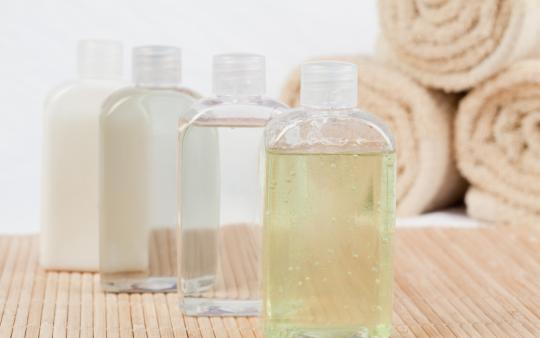Many of us start to think more about what goes in and on our bodies once we’re expecting a baby. Unfortunately, there are a number of not-so-great chemicals used in everyday products, many of which have not been tested thoroughly before being introduced to the market. It’s no secret that what we put on our bodies can end up in them. And babies and young children are more susceptible to the harmful impacts of chemicals in our everyday products because their bodies are much smaller and still developing. Packaging terms like “for baby” or “dermatologist tested” are not reliable ways to determine whether a product uses the safest ingredients.
Let’s take a look at how you can reduce your baby’s exposure to harmful ingredients by making your own baby care products with some easy recipes. And even if DIY isn’t your thing, keep reading because I’ve got some great label-reading tips and tools to share too.
DIY should I?
Making your own products is the easiest way to truly know what goes into them. Once I started dabbling in homemade cleaners and then body care, baby care products came naturally. Another perk is that homemade products are often more budget-friendly than natural commercial products. I recommend just trying out one recipe — it’s empowering to know that you can, and it’s so easy you’ll probably be hooked! Here are two basic recipes that are great to get you started:
Homemade Baby Wipes Recipe
Conventional wipes may contain synthetic fragrance and harmful preservative chemicals. Homemade wipe solution is easy to make, and contains skin-soothing ingredients to help prevent diaper rash. Reduce waste by using reusable cloths (and you'll have no extra laundry if you’re already cloth diapering!).
Ingredients
- ¼ cup castile soap
- ¼ cup oil (like calendula, sweet almond, apricot kernel, or castor)
- 2 cups water
Instructions
- Mix ingredients in a glass jar.
- Soak reusable cloths or strong paper towel in solution and apply as needed.
Shelf life: 1 month.
TIP: You can buy cloth wipes, or save money and make them by cutting up old T-shirts, soft towels, etc.
Homemade Baby Powder Recipe
In 2016, a judge awarded $72M in damages to the family of a woman who died of ovarian cancer after 35 years of using talc-based powder. The possibility that talc may contribute to ovarian cancer has many parents looking for alternatives to conventional baby powder.
This recipe is great because one batch has four uses: baby powder, dry shampoo, body powder, and deodorizer. Here’s how to make and use it for baby powder!
Ingredients
- ¼ cup corn starch
- ¼ cup arrowroot powder
- 1 tbsp white clay (found in health food stores)
Optional: 6 drops essential oil (e.g. 3 drops sweet orange, 2 drops ylang ylang, 1 drop geranium)
Note that while the ingredients are non-toxic, they can irritate the respiratory tract. Dab onto baby rather than shaking to avoid inhalation.
If you’ve been using baby powder out of habit, try your diaper change routine without it to see if it’s actually needed — because even better than making your own is to use nothing!
(Recipes shared with permission by Lindsay Coulter, a fellow Queen of Green)
How to Buy Better
If DIY isn’t your thing (it isn’t always mine!), or if you want to have some store-bought products on hand, there are some great tools available to help you read labels. First, it’s important to turn the product around and read what’s in it. The front labels often tell you what the product doesn’t have, making it sound better than it may actually be.
Avoiding undisclosed fragrance ingredients, petrolatum, phthalates, and parabens is a great place to start. But it’s difficult to keep all these ingredients in mind, especially if you’re new to label reading. Luckily, you’ve got some options to help you out!
Online Help
EWG's Skin Deep Website – The mother of all product databases. A detailed, searchable, online database of common body and baby care products and ingredients. Great for doing deeper research into products and/or individual ingredients.
Wallet Guides
The David Suzuki Foundation, Environmental Working Group and Environmental Defense Canada have wallet guides available to help you identify the top ingredients to avoid in body care products. You can download and print if you prefer a low-tech option.
Apps to download
If you live in Canada:
Think Dirty App: This app allows you to scan product barcodes and see how they rate on a scale of 0 (safe ingredients) to 10 (potentially harmful ingredients). It provides you with a breakdown of ingredients, what they’re used for, and what the concern is for human and environmental health. It includes baby care products such as shampoo, soap, diaper cream, and wipes.
If you live in the United States:
EWG's Healthy Living App: Includes ratings for about 120,000 personal products and foods, with a barcode scanner system to help you out when you’re out and about.
By consciously choosing to use all-natural, healthier products, you’re reducing your baby’s exposure to chemicals that may contribute to cancer, reproductive health concerns, allergies, and asthma. DIY is one option that puts you in the driver’s seat, but know that there are great products out there on store shelves. It just takes some time and effort up front to get familiar with the products and how to read labels. You’ll thank yourself later!






